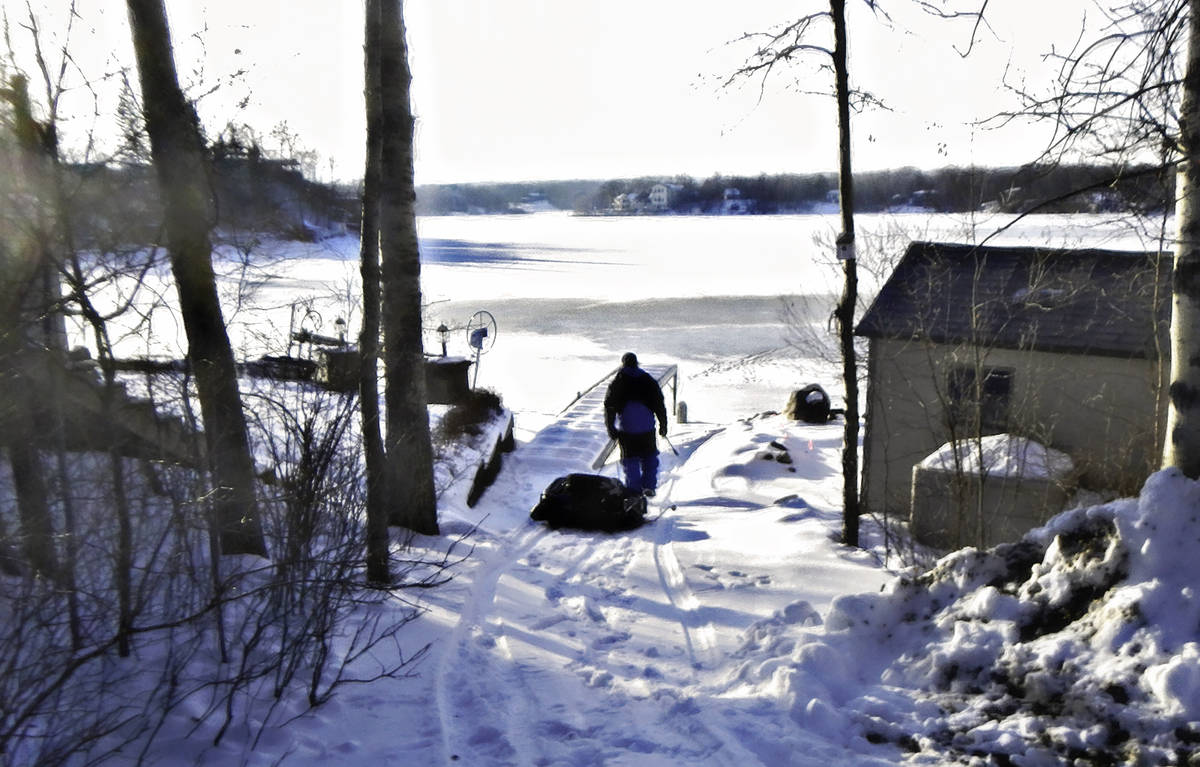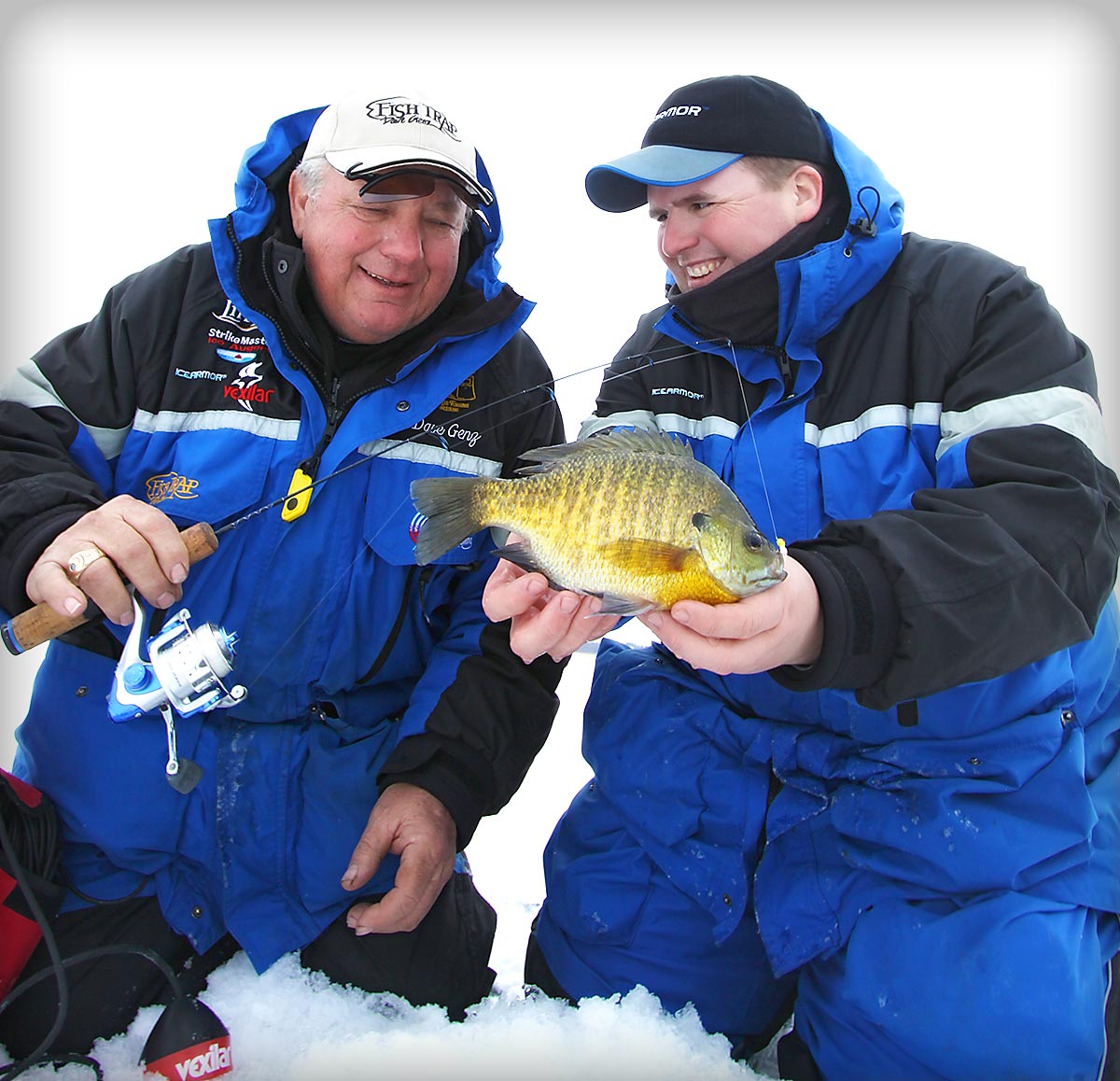 Check the conditions and bring safety gear!
Check the conditions and bring safety gear!
When it comes to ice safety, Dave Genz has always said essentially the same thing: if you move more, you will catch more fish. He wants ice anglers to be mobile, but be careful.
He’s a picture of consistent safety precautions, wearing a life jacket outside his Ice Armor parka, using ice cleats for solid traction, punching the ice with a chisel ahead of himself, testing for thickness, as he walks on early or questionable ice. Today, he wants to talk ice safety over the entire course of the winter. “You never know when it could happen, that you could fall through,” he says, “but if you have the right stuff with you, you should be able to get out alright.”
Two Aspects of Ice Safety
Really, there are two aspects to ice safety.
- Learning to identify situations that have the potential for producing unsafe ice.
- Being ready with the right gear, should you or someone around you fall through the ice.
Let’s look at both aspects.
Potential for Unsafe Ice
Ice conditions can and do vary from spot to spot on the same body of water, and vary tremendously from region to region. In some parts of the ice belt, cold weather comes and goes – so safe ice forms, then might erode, even at midwinter. Especially in today’s connected world, where we all see Facebook posts with pictures of good catches, the fever can sweep over people living in fringe areas. It can be tempting to try to add your own pictures to the reports, even if the ice is iffy, at the moment, where you live.
Iffy ice conditions can always occur in places where water is moving due to currents or aeration devices, and around springs. This is true even in the ‘True North’ where cold weather usually remains for months on end.
Also avoid expansion cracks, or ‘pressure ridges’ as they’re called.
It pays to know when significant snow fell on top of the ice you are about to venture onto. All things being equal, it’s thought that ice should be at least six inches thick before the first good snow settles on top of it. If heavy snow falls on thin ice, the blanket of snow can insulate the ice, preventing it from getting thicker. Even with sustained cold temperatures, you can have thin ice under the snow. Again, it all depends on when that snow fell.
It’s easier than ever to gather information on known currents, springs, and other traditionally iffy ice areas, and to get details on what went down, weather wise, as ice was forming. Seek this information but couple it with your own observations, precautions, and common sense.
Flotation, Picks, and a Chisel
Genz has always thought it strange that safety experts switch advice abruptly after ice forms. “If you’re going out in a boat on cold water,” he says, “they tell you to wear a life jacket. Then, a week later, after the ice comes, they tell you to stay home. Why can’t we talk about wearing a life jacket when you go out on the ice?”
He makes a good point. Once temps chill off into ice-making range, it takes little time for safe ice to form. (It can happen overnight, in perfect conditions, and certainly within a few days, with cold temperatures, safe walkable ice can form.) And first-ice fishing can be excellent. Read this clearly, exactly how it’s intended: check ice carefully, and wear flotation clothing above the waist just in case.
“We have a new life vest,” says Dave, referring to the Clam life vest, “that’s Coast Guard approved and cut to fit over your suit. It has a lot of features, including a quick-release velcro holder for ice picks. It helps keep your core warm, and has soft pockets for drying and warming your hands. And we have floating ice picks.”
 Dave advises people to go ice fishing with at least one partner, and stay close enough to each other to be able to help if one falls through. It’s rare for this to happen, but if it does, a second person can be instrumental in getting the dunked angler back up on safe ice and headed in to warm up. If the assisting person can approach on safe ice but keep distance while rendering help, the odds of a good outcome are greatly improved.
Dave advises people to go ice fishing with at least one partner, and stay close enough to each other to be able to help if one falls through. It’s rare for this to happen, but if it does, a second person can be instrumental in getting the dunked angler back up on safe ice and headed in to warm up. If the assisting person can approach on safe ice but keep distance while rendering help, the odds of a good outcome are greatly improved.
“That’s why we made the emergency throw rope,” Genz said, referring to another new accessory now readily available at retail. “You can make your own, or this one works really well. It looks like a dog dummy that’s packed with rope. You hang on to the loose end of the rope and throw the thing to the person in the water, and the rope plays out as it flies through the air. It stores 50 feet of rope in a neat package, and you can keep it in your Fish Trap or strap it to an ATV or snowmobile.”
For the ultimate in protection, Genz talks about the Lift Suit, an ice-fishing specific suit made with extra flotation that helps you stay upright and floating in the event you break through. He finishes the thought by adding that floating ice picks and chisels have also been brought into the lineup, to make sure anglers can find everything they need easily.
We almost forgot: spikes. Sometimes called ice cleats, or creepers. They strap onto your boots, fitting you with ice-gripping traction. They’re crucial any time there’s no snow on the ice. They can prevent slipping and falling, which can (and does) lead to injuries. Genz mentions Micro Spikes by Kahtoola, but stresses that the most important thing is to get some and use them.
“This is the stuff that doesn’t get talked about enough,” says Genz, “because it’s not really fishing equipment. And it’s not that we’re saying that ice fishing is dangerous. You’ll probably fish your whole life without needing most of this stuff, but if somebody falls through and you don’t have it along, you’ll wish you did.”
Amen, and a major understatement.
Note: Dave Genz, known as Mr. Ice Fishing, was the primary driver of the modern ice fishing revolution. He has been enshrined in the National Fresh Water Fishing Hall of Fame and Minnesota Fishing Hall of Fame for his contributions to the sport. For more fishing tips and to order his new info-packed book, Ice Revolution, go to www.davegenz.com.










